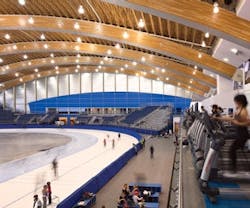Wooden “Wave” Unites Diverse Solutions
Return to Introductory Article
As the signature speed-skating venue for the 2010 Olympic Games, the Richmond Oval near Vancouver, BC, was seen by millions of viewers around the world. But after a global gala, how can such a facility maintain its vitality for years to come?
Indoor Olympic facilities with 400-meter tracks are huge, and they can face huge revenue challenges post-Games. That undesired possibility drew the attention of the project team from the outset.
"We began where we wanted to end," says Ken Wiseman, president of architect Cannon Design. "We did a market analysis and a full-blown pro forma for the after-use, and we identified market gaps to fill."
Staying within Budget Parameters
As a public amenity, the Oval now operates profitably with three activity zones – an ice zone, a court zone, and a track zone – and various fitness and training areas. It has been a catalyst and centerpiece for the transformation of Richmond's riverfront area into a high-density, urban neighborhood.
GRAND PRIZE:
Richmond Oval
CATEGORY: NEW CONSTRUTION
A signature visual feature of the Oval is its wood roof deck and composite glulam arches. The integration of building systems into the wood structure had the effect of distributing the cost of the wood components over other system costs, creating a net savings.
The Oval's main structure is comprised of 15 composite wood gluelam arches from locally harvested Douglas fir. The lumber was formed into a V-shaped composite to achieve the span and carried on 30 concrete buttresses. An interstitial space inside the V is used for air distribution and services, displacing the cost of mechanical duct and roof support struts. The gluelam surfaces are perforated with 250mm holes that accommodate jet nozzles for ventilation. The nozzles are motorized to control the delivery of conditioned air to the activity areas below and to provide environmental separation between the ice rinks and dry-land sport functions.
The Oval's roof deck and the secondary structural panels spanning the 15 meters between the glulam arches are composed of regionally harvested, pine-beetle-killed wood in the form of standard 2 x 4 lumber. The lumber was nailed together to form a V-shaped wood box, and arched to create the vaulted ceiling panels forming the "wood wave."
While the mass and softness of the pine decking provide a higher degree of acoustical control than a steel deck, other features of the decking also make an acoustical contribution. Slot-like perforations in the deck were sized and tested prior to mass-production of the deck, and an acoustical lining on the inside of the panels was also tested and installed.
The combustibility of wood was another factor for the ceiling. The building code for structures of this size requires noncombustible construction. Cannon Design's consultants provided significant fire engineering modeling to obtain an equivalency under the British Columbia Building Code and thus enable combustible roof construction. Fire sprinkler heads are positioned as necessary in the decking's slots.
Underlining Local Arts and Community
Carved three-dimensional reliefs depicting water, herons, salmon, and other motifs significant to aboriginal traditions and Richmond's contemporary culture are inlaid into channels in 15 massive concrete buttresses on the north side of the Oval, which faces a large festival plaza.
The use of First Nations art in the Olympic Oval acknowledges the site's historical and cultural significance and Richmond's ongoing commitment to recognize those interests in the redevelopment of the river site.

